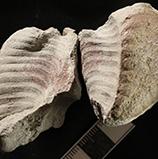
Simon Darroch, G&G graduate student, Marc Laflamme, (previous postdoc in G&G and currently an Assistant Professor with the Smithsonian Institute), and Erik Sperling (Agouron Postdoctoral Fellow, Harvard University) receive a National Geographic Society Research and Exploration grant in support of their project “The Ediacaran extinction and the dawn of animal life”.
Together with an interdisciplinary team of geoscientists, they will be tackling many aspects of the Precambrian-Cambrian transition in southern Namibia, including the paleontology, geochemistry, geochronology and sequence stratigraphy of the Nama Group in southern Namibia. Simon Darroch will be looking at the paleoecology of Ediacaran fossils found within these rocks, examining their spatial and stratigraphic relationships, diversity, and preservation. These investigations will provide valuable clues as to where the Ediacaran organisms fit in the tree of life, and what ecological roles they played in the rapidly changing world that precluded the Cambrian explosion.
Simon expects to be in the field for at least a month between May and June, with Erik Sperling and Marc Laflamme.
Abstract
“The Ediacaran period (635-542 Ma) represents a pivotal time in Earth history, marked by the transition from single-celled organisms into complex animals. Typifying this transition is the Ediacara biota, a group of soft-bodied organisms whose affinities are fiercely debated, and whose disappearance from the fossil record prior to the Cambrian explosion of complex animals is equally perplexing. Three main hypotheses have been proposed to explain the disappearance of the Ediacara biota: 1) an ecologically-driven mass extinction event, 2) gradual competitive replacement of the Ediacara biota by newly-evolved Cambrian animals, and 3) the elimination of the unique preservational settings that allowed for the preservation of the Ediacara biota. To tackle the questions surrounding the disappearance of the Ediacara biota and the subsequent emergence of animals, we propose field research in southern Namibia. Namibia has abundant rocks representing the brief critical interval where animal and Ediacaran faunas overlapped, and include well-exposed outcrops for sequence stratigraphy and reliable age constraints from volcanic ashes. Although collections of Namibian Ediacaran fossils date back to the early twentieth century, Namibia remains poorly studied, and is ripe for extensive exploratory field work. The Nama Group of southern Namibia contains beautifully exposed sections, most of which have yet to be explored, let alone studied in detail. In the wake of the Cambrian radiation, environmental, biological, and ecological changes converged and resulted in the first large-scale extinction of complex life, and ultimately one of the most widespread evolutionary turnovers in the history of life on Earth.”